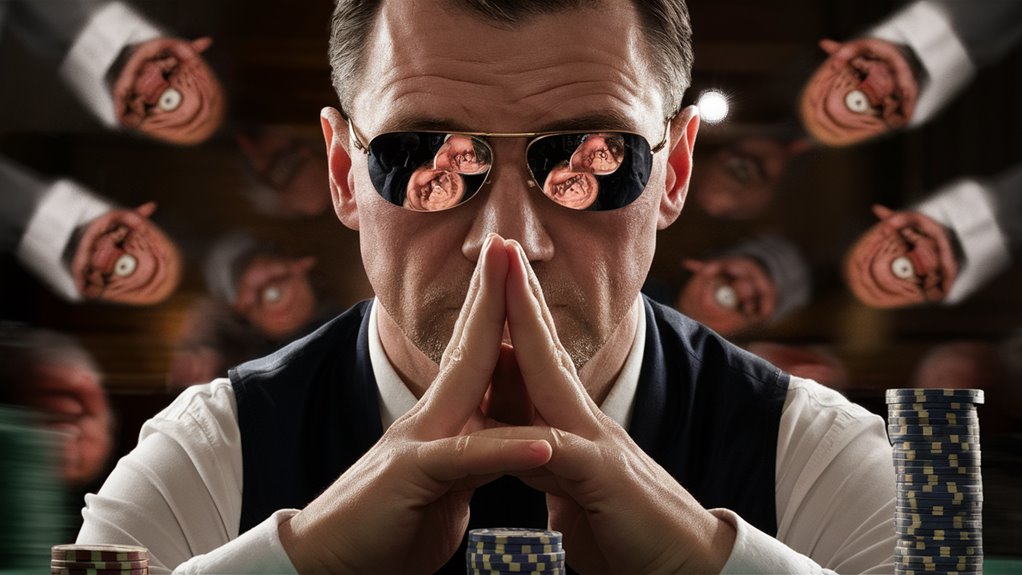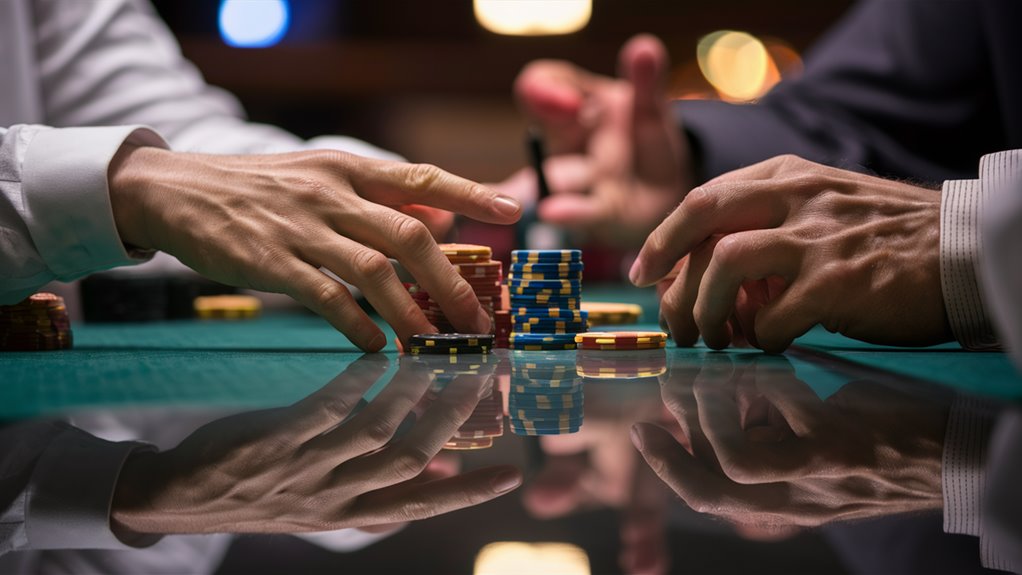Elite Poker Psychology: Advanced Mental Warfare Strategies
Mastering Psychological Warfare in Poker
Poker psychology extends far beyond mathematical calculations, requiring a sophisticated blend of mental tactics and emotional intelligence. Elite players dominate through carefully orchestrated psychological warfare, combining deceptive strategies with precise emotional control.
Building Your Psychological Arsenal
Table presence forms the foundation of psychological dominance. Develop a consistent persona that masks your intentions while projecting calculated confidence. Master advanced breathing techniques like the 4-7-8 method to maintain physiological control during high-pressure situations.
Reading Opponents Through Behavioral Analysis
Strategic observation of opponents reveals crucial patterns:
- Monitor baseline behaviors during neutral hands
- Track physical tells including shoulder tension
- Observe breathing rhythm changes
- Note micro-expressions during betting sequences
Advanced Psychological Tactics
Layer multiple psychological techniques:
- Timing manipulation in betting patterns
- Strategic table talk to induce mistakes
- Selective aggression to create pressure points
- Pattern disruption to confuse regular opponents
FAQ: Poker Psychology Mastery
Q: What are the most reliable physical tells in poker?
A: Focus on involuntary responses like breathing changes, carotid artery pulsing, and hand tremors.
Q: How can I maintain emotional control during big hands?
A: Practice systematic breathing techniques, develop pre-planned responses, and maintain consistent betting patterns.
Q: What psychological tactics work best against professional players?
A: Pattern disruption, timing manipulation, and selective information sharing prove most effective.
Q: How do I prevent opponents from reading my tells?
A: Establish consistent behaviors, maintain steady breathing, and practice neutral expressions.
Q: What’s the best way to induce mistakes from opponents?
A: Create time pressure, use strategic table talk, and implement unexpected betting patterns.
Building Your Table Persona

Mastering Your Poker Table Persona: A Strategic Guide
Building an Effective Table Image
Professional poker players understand that a carefully crafted table persona is essential for competitive advantage.
A well-developed persona masks your true playing style while creating strategic discomfort for opponents, leading to exploitable mistakes and enhanced profitability.
Three Dominant Poker Personas
The Silent Professional
- Minimal movement patterns
- Calculated decision timing
- Limited verbal interaction
- Consistent physical presence
The Social Strategist
- Strategic conversation flow
- Behavioral observation techniques
- Targeted question patterns
- Relationship building dynamics
The Dynamic Player
- Controlled unpredictability
- Strategic timing variations
- Calculated emotional displays
- Pattern disruption tactics
Advanced Persona Implementation
Developing your poker table image requires integrating natural tendencies with strategic elements. Focus on:
- Breath control techniques
- Consistent betting rhythms
- Physical tell suppression
- Character maintenance during crucial hands
FAQ: Table Persona Mastery
Q: How long should I maintain my chosen persona?
A: Maintain your selected persona throughout entire sessions for maximum effectiveness.
Q: Can I switch between different personas?
A: Switching personas should be limited to different sessions to maintain authenticity.
Q: How do I choose the right persona?
A: Select a persona that aligns with your natural tendencies while serving strategic objectives.
Q: What’s the most effective persona for beginners?
A: The Silent Professional typically offers beginners the best foundation for development.
Q: How do I practice my table persona?
A: Regular implementation in low-stakes games helps perfect persona execution.
Reading Physical Tell Patterns
Mastering Poker Tell Patterns: A Complete Guide
Understanding Physical Tells in Poker
Professional poker players develop an exceptional ability to detect and interpret physical tells – unconscious behaviors that reveal critical information about hand strength and emotional states.
The foundation of tell reading begins with establishing each player’s baseline behavior during neutral situations, then identifying meaningful deviations.
Key Areas for Tell Detection
Hand and Chip Movements
Chip handling patterns and card management serve as primary indicators of a player’s comfort level.
Unusual movements or disrupted patterns often signal either exceptional confidence or significant discomfort with their current hand.
Breathing Analysis
Respiratory patterns provide reliable tells during crucial moments:
- Rapid, shallow breathing indicates stress or anxiety
- Controlled, deliberate breaths may suggest a calculated bluff
- Irregular breathing rhythms often correlate with hand strength uncertainty
Physical Tension Indicators
Neck and shoulder tension combined with other tells creates a more complete picture of an opponent’s state.
Multiple tell combinations prove more reliable than isolated behaviors.
Advanced Tell Reading Strategy
Focus on critical timing windows:
- Immediately after players view their cards
- During betting action
- At showdown approach
Expert players may deliberately display false tells, making it essential to cross-reference physical indicators with betting patterns and previous gameplay history.
FAQ Section
Q: What’re the most reliable poker tells?
A: The most dependable tells include breathing patterns, chip handling changes, and combinations of multiple physical indicators.
Q: How can you spot a poker bluff?
A: Look for inconsistencies between betting patterns and physical behavior, especially controlled breathing and forced relaxation.
Q: Are online poker tells different from live tells?
A: Yes, online tells focus on betting patterns and timing rather than physical behaviors.
Q: How long does it take to master tell reading?
A: Developing proficient tell reading typically requires several months to years of dedicated practice and observation.
Q: Can tells be used against experienced players?
A: While experienced players may control obvious tells, unconscious behaviors can still provide valuable information when properly analyzed.
Strategic Mind Game Techniques

Advanced Poker Psychology: Strategic Mind Game Techniques
Mastering Mental Warfare in Poker
Strategic mind games form the cornerstone of high-level poker play, extending far beyond basic physical tells into sophisticated psychological warfare.
The art of mental 먹튀검증 manipulation at the poker table requires masterful command of timing, misdirection, and behavioral control.
Timing Manipulation Strategies
Variable timing patterns create powerful uncertainty in opponents’ decision-making processes.
Implementing deliberate speed variations between hands masks hand strength and generates confusion. Strategic pauses and snap-decisions become weapons when deployed unpredictably, regardless of actual holdings.
Psychological Warfare Tactics
Advanced table talk serves as a crucial tool for planting doubt in opponents’ minds.
Strategic comments about previous hands, carefully timed observations, and calculated conversations create a complex web of uncertainty. This verbal misdirection compounds decision pressure on opponents during critical moments.
Implementing False Tells
Deceptive behavioral patterns represent a sophisticated weapon in psychological gameplay.
Deliberately displaying strength during weak hands and projecting nervousness with premium holdings establishes exploitable patterns. Strategic hand selection at showdown reinforces carefully crafted table images.
FAQ: Poker Psychology Mastery
Q: How do you maintain consistent psychological control?
A: Focus on layered deception patterns while varying strategic approaches throughout sessions
Q: What’re the most effective psychological tactics?
A: Timing manipulation, strategic conversation, and carefully planned false tells
Q: How important is table image in psychological warfare?
A: Critical – it forms the foundation for advanced deception strategies
Q: When should you reveal hands at showdown?
A: Selectively show hands that reinforce your intended table image
Q: How do you prevent opponents from detecting patterns?
A: Regularly adjust timing and behavioral patterns while maintaining unpredictability
Advanced Implementation
The mastery of poker psychology requires weaving multiple elements into a seamless strategy.
Building complex deception layers while maintaining credibility creates lasting advantages. Strategic shifts during high-stakes moments maximize psychological pressure and exploitation opportunities.
Emotional Control Under Pressure
Mastering Emotional Control Under Pressure: A Comprehensive Guide
Core Psychological Skills for Peak Performance
Developing emotional equilibrium under intense pressure requires mastering three foundational psychological skills: impulse control, cognitive reframing, and physiological regulation.
These crucial abilities form the backbone of superior mental performance in high-stakes situations.
Implementing Strategic Impulse Control
The five-second rule serves as a powerful psychological anchor for maintaining composure during critical moments.
By implementing a mandatory cooling-off period before significant decisions, practitioners can effectively prevent emotional decision-making and maintain objective analysis. This structured approach proves particularly valuable when facing challenging situations or potential losses.
Mastering Cognitive Reframing Techniques
Advanced cognitive reframing transforms setbacks into valuable learning experiences.
High-performing individuals consistently interpret negative outcomes as validation of sound strategy rather than personal failure. This mental recalibration maintains strategic clarity and prevents emotional deterioration during crucial moments.
Physiological Response Management
The 4-7-8 breathing technique represents a scientifically-proven method for maintaining physiological control:
- Inhale deeply for 4 seconds
- Hold breath for 7 seconds
- Exhale completely for 8 seconds
This advanced breathing protocol effectively regulates the nervous system, enabling sustained focus and emotional stability during high-pressure situations.
Frequently Asked Questions
Q: How long does it take to develop effective emotional control?
A: Consistent practice typically yields noticeable improvements within 4-6 weeks, with mastery developing over 3-6 months.
Q: Can emotional control techniques work in non-competitive situations?
A: Yes, these strategies prove equally effective in professional, personal, and social contexts.
Q: What’re the signs of improving emotional control?
A: Key indicators include reduced reactive behavior, better decision-making under pressure, and consistent performance during stressful situations.
Q: How often should breathing exercises be practiced?
A: Daily practice of 10-15 minutes yields optimal results, with additional application during high-stress moments.
Q: Are there different techniques for different pressure situations?
A: Yes, varying combinations of impulse control, cognitive reframing, and breathing techniques can be tailored to specific challenging scenarios.
Exploiting Psychological Weaknesses

Mastering Psychological Dynamics in Competitive Poker
Understanding Player Psychology
Psychological vulnerabilities represent a critical competitive edge in high-stakes poker.
Players consistently demonstrate predictable behavioral patterns under stress, creating exploitable opportunities.
Key psychological profiles include:
- Tilt-prone players who chase losses emotionally
- Risk-averse competitors who fold under pressure
- Overconfident opponents who consistently overvalue hands
Strategic Exploitation Methods
Advanced player profiling requires systematic observation of betting patterns, physical tells, and timing rhythms.
Implementing targeted counter-strategies:
- Apply increased betting pressure against tilting players
- Execute calculated bluffs against conservative opponents
- Deploy trap plays against aggressive, overconfident players
Timing and Implementation
Strategic timing maximizes exploitation effectiveness.
Pressure points include:
- Post-loss scenarios
- High-stakes situations
- Tournament bubble phases
- Critical stack-size thresholds
Frequently Asked Questions
Q: How do you identify tilt-prone players?
A: Look for increased betting frequency, deviation from standard patterns, and visible emotional reactions to losses.
Q: What’re effective counter-strategies against overconfident players?
A: Implement trap plays, allow them to lead betting, and capitalize on their tendency to overcommit with marginal hands.
Q: How can you exploit risk-averse opponents?
A: Increase bluffing frequency, apply consistent pressure, and target their tendency to fold under aggression.
Q: When is the optimal time to exploit psychological weaknesses?
A: During high-pressure situations, after significant losses, and when stack sizes create additional stress.
Q: How do you maintain your own psychological stability while exploiting others?
A: Focus on objective decision-making, maintain emotional distance, and stick to predetermined strategic plans.
